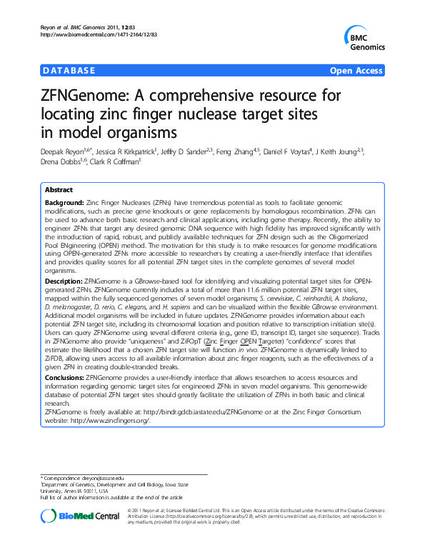
Background: Zinc Finger Nucleases (ZFNs) have tremendous potential as tools to facilitate genomic modifications, such as precise gene knockouts or gene replacements by homologous recombination. ZFNs can be used to advance both basic research and clinical applications, including gene therapy. Recently, the ability to engineer ZFNs that target any desired genomic DNA sequence with high fidelity has improved significantly with the introduction of rapid, robust, and publicly available techniques for ZFN design such as the Oligomerized Pool ENgineering (OPEN) method. The motivation for this study is to make resources for genome modifications using OPEN-generated ZFNs more accessible to researchers by creating a user-friendly interface that identifies and provides quality scores for all potential ZFN target sites in the complete genomes of several model organisms.
Description: ZFNGenome is a GBrowse-based tool for identifying and visualizing potential target sites for OPENgenerated ZFNs. ZFNGenome currently includes a total of more than 11.6 million potential ZFN target sites, mapped within the fully sequenced genomes of seven model organisms; S. cerevisiae, C. reinhardtii, A. thaliana, D. melanogaster, D. rerio, C. elegans, and H. sapiens and can be visualized within the flexible GBrowse environment. Additional model organisms will be included in future updates. ZFNGenome provides information about each potential ZFN target site, including its chromosomal location and position relative to transcription initiation site(s). Users can query ZFNGenome using several different criteria (e.g., gene ID, transcript ID, target site sequence). Tracks in ZFNGenome also provide “uniqueness” and ZiFOpT (Zinc Finger OPEN Targeter) “confidence” scores that estimate the likelihood that a chosen ZFN target site will function in vivo. ZFNGenome is dynamically linked to ZiFDB, allowing users access to all available information about zinc finger reagents, such as the effectiveness of a given ZFN in creating double-stranded breaks.
Conclusions: ZFNGenome provides a user-friendly interface that allows researchers to access resources and information regarding genomic target sites for engineered ZFNs in seven model organisms. This genome-wide database of potential ZFN target sites should greatly facilitate the utilization of ZFNs in both basic and clinical research. ZFNGenome is freely available at: http://bindr.gdcb.iastate.edu/ZFNGenome or at the Zinc Finger Consortium website: http://www.zincfingers.org/.
Available at: http://works.bepress.com/drena-dobbs/18/

This article is from BMC Genomics 12 (2011): 83, doi: 10.1186/1471-2164-12-83. Posted with permission.